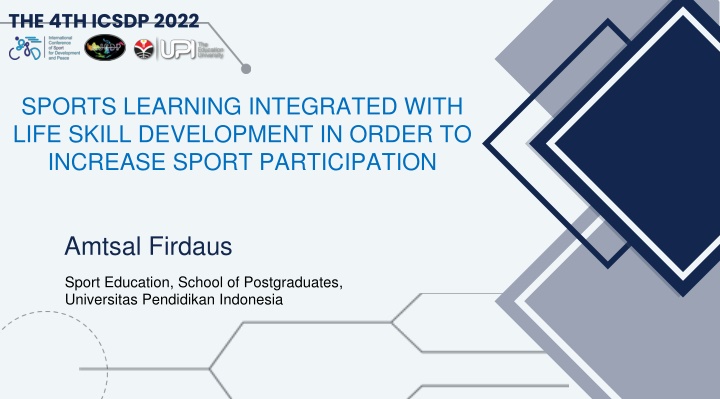
Impact of Integrated Sports Learning on Life Skills Development
Explore how sports education intertwines with life skill development to enhance sport participation and overall well-being, emphasizing the importance of physical and mental fitness in a societal context. Delve into the benefits of sports education in shaping character and fostering a healthy lifestyle from childhood to adulthood.
Download Presentation

Please find below an Image/Link to download the presentation.
The content on the website is provided AS IS for your information and personal use only. It may not be sold, licensed, or shared on other websites without obtaining consent from the author. If you encounter any issues during the download, it is possible that the publisher has removed the file from their server.
You are allowed to download the files provided on this website for personal or commercial use, subject to the condition that they are used lawfully. All files are the property of their respective owners.
The content on the website is provided AS IS for your information and personal use only. It may not be sold, licensed, or shared on other websites without obtaining consent from the author.
E N D
Presentation Transcript
THE 4TH ICSDP 2022 SPORTS LEARNING INTEGRATED WITH LIFE SKILL DEVELOPMENT IN ORDER TO INCREASE SPORT PARTICIPATION Amtsal Firdaus Sport Education, School of Postgraduates, Universitas Pendidikan Indonesia
INTRODUCTION Education as a means to prepare young people to be able to live in a society with social welfare. Sports education does not only teach students how sports can be done, but can provide values for living health physically, mentally, and socially. This article aims at how sports learning can have a real impact on students for their preparation as adults by focusing on sports learning to improve life skills and participation in sports in the community.
INTRODUCTION The need for a good quality of life, having physical fitness, physically and mentally healthy becomes the basis for a person to carry out his daily routine/habits by doing a variety of physical activities to make it a life skill (Nuzzo, 2020). Physical education teachers help students stay mentally healthy, raise the bar for making healthy choices in life, and develop character from childhood to adulthood. (Ali et al., 2021). Factors that influence sports participation are very important to encourage children to engage in physical activity and develop an active lifestyle (De Meester et al., 2020).
INTRODUCTION Participation in sport is seen as a major means of promoting health and well-being in many countries (Mansfield & Piggin, 2016). More than 70% of Canadian high school participated in organized sports as a medium to augment or enhance learning experiences for young people, contribute to their personal development and provide many psychological and social benefits (Desroches et al., 2022). students participate in or have
METHODS This article is a literature review that contains literature or literature review that discusses sports learning with integrated life skills so that it can increase participation in sports outside of school. therefore the method used by the author is descriptive qualitative analysis by conducting a literature study with the aim of being able to describe the problem, or concept that is the focus of research by examining secondary data in the form of journals, scientific articles, news, electronic and digital sources, as well as various other relevant sources. with article discussion.
THE 4TH ICSDP 2022 Result and discussion The National Federation of State High School Associations (NFHS) in 2017 released that in the United States about 7.9 million high school students (56%), playing several types of sports with a tendency to increase sports participation over time, and participation in sports that held by secondary schools has steadily increased over the last 25 years (Ransom & Ransom, 2018). In order participation, various sports-based programs that are intentionally aimed at teaching life skills have been developed by researchers, life skills classified as intrapersonal (that is skills that are more internal, such as focus) or interpersonal (that is useful skills). during social interactions, such as the ability to work in a team); This framework combines two core life skills (focus and sportsmanship) and six related life skills (persistence, goal setting, emotional regulation, honesty, teamwork, and respect) (Kendelle & Camir , 2017). to maximize the benefits of developing youth sports
THE 4TH ICSDP 2022 Conclusion From the results of a literature study, it can be concluded that sports learning with integrated life skills is very important to increase sports participation outside school. Therefore, the author here can answer and conclude the questions from the problems studied. There is an increase in sports participation from children to adults. In addition, people become healthy because of increased sports participation. So it is necessary to integrate sports learning which is integrated into life skills to prepare students for the future. So that awareness of the importance of sports can maintain student participation in sports until they are adults.
THE 4TH ICSDP 2022 References Ali, M. F., Kundra, S., Alam, M. A., & Alam, M. (2021). Investigating stress, anxiety, social support and sex satisfaction on physical education and sports teachers during COVID-19 pandemic. Heliyon, 7(8), e07860. https://doi.org/10.1016/j.heliyon.2021.e07860 Bean, C., & Forneris, T. (2016). Examining the Importance of Intentionally Structuring the Youth Sport Context to Facilitate Positive Youth Development. Journal of Applied Sport Psychology, 28(4), 410 425. https://doi.org/10.1080/10413200.2016.1164764 De Meester, A., Wazir, M. R. W. N., Lenoir, M., & Bardid, F. (2020). Profiles of Physical Fitness and Fitness Enjoyment Among Children: Associations With Sports Participation. Research Quarterly for Exercise and Sport, 93(1), 26 35. https://doi.org/10.1080/02701367.2020.1788700 Desroches, G., Poulin, F., & Denault, A. S. (2022). Sports participation patterns throughout high school and their antecedents. Applied Developmental Science, 26(1), 31 https://doi.org/10.1080/10888691.2019.1687297 Gokce, H., & Bozyigit, E. (2020). Satisfaction Levels of Sports Event Participants. Journal of Education and Learning, 9(1), 136. https://doi.org/10.5539/jel.v9n1p136 Gould, D., & Carson, S. (2008). Life skills development through sport: current status and future directions. International Review of Sport and Exercise Psychology, 1(1), 58 78. https://doi.org/10.1080/17509840701834573 Haynes, A., McVeigh, J., Hissen, S. L., Howie, E. K., Eastwood, P. R., Straker, L., Mori, T. A., Beilin, L., Ainslie, P. N., & Green, D. J. (2021). Participation in sport in childhood and adolescence: Implications for adult fitness. Journal of Science and Medicine in Sport, 24(9), 908 912. https://doi.org/10.1016/j.jsams.2021.05.004 Kendellen, K., & Camir , M. (2017). Examining the life skill development and transfer experiences of former high school athletes. International Journal of Sport and Exercise Psychology, 15(4), 395 408. https://doi.org/10.1080/1612197X.2015.1114502 Lee, R. P., & Potrac, P. (2021). Understanding (disrupted) participation in community sports clubs: Situated wellbeing, social practices and affinities and atmospheres. Wellbeing, Space and Society, 2, 100005. https://doi.org/10.1016/j.wss.2020.100005 Newman, T. J. (2020). Life Skill Development and Transfer: They re Not Just Meant for Playing Sports. Research on Social Work Practice. https://doi.org/10.1177/1049731520903427 Nuzzo, J. L. (2020). The Case for Retiring Flexibility as a Major Component of Physical Fitness. Sports Medicine. https://doi.org/10.1007/s40279-019-01248-w Ransom, M. R., & Ransom, T. (2018). Do high school sports build or reveal character? Bounding causal estimates of sports participation. Economics of Education Review 64(January), 75 89. https://doi.org/10.1016/j.econedurev.2018.04.002






















